It’s possible that I shall make an ass of myself. But in that case one can always get out of it with a little dialectic. I have, of course, so worded my proposition as to be right either way (K.Marx, Letter to F.Engels on the Indian Mutiny)
Thursday, December 22, 2022
Thu, December 22, 2022
BEIJING, Dec. 22, 2022 /PRNewswire/ -- Chinese people and American people have a rich history of friendship and if we can successfully create opportunities to work together, this world will become a better place, Adam Foster, president of the Helen Foster Snow Foundation, who penned a letter to Xi Jinping, told the Global Times.
In a letter of reply in January 2022, Xi pointed out that Edgar and Helen Snow actively promoted the Chinese Gong He (Gung Ho) movement of industrial cooperatives, and played an important role in establishing the Shandan Peili School in China's Gansu Province.
The Chinese people, he added, bear in mind the contributions made by international friends, including the Snows, to China's revolution and construction, as well as their sincere friendship with the Communist Party of China (CPC) and the Chinese people.
Xi said he highly appreciates the positive contributions made by the Helen Foster Snow family to the development of China-US relations over the years.
He expressed his hope that Foster and the foundation will continue to follow the example of the Snows and make new contributions to enhancing the friendship and cooperation between the Chinese and American people.
Xi's reply came after Adam Foster had written to him, recalling the contributions made by Helen Snow to enhancing people-to-people friendship between the US and China.
He also vowed to carry forward her spirit of promoting friendship and cooperation between the people of the two countries and create a bridge for US-China people-to-people exchanges and interaction.
"It was really encouraging to see that leaders from both sides are looking for ways to keep that people-to-people connection… I hope that relationship continues," Adam Foster told the Global Times.
"We wrote a letter to President Xi, and that was signed by 66 members of the Foster family, thanking the Chinese people for what they've done to celebrate Helen and to honor her legacy," said Foster.
Continuing the legacy
Helen Foster Snow, great-aunt of Adam Foster, together with Edgar Snow, whom she met and married in China, championed the practice of making the CPC known to the world through their writings on the Party and the Chinese revolution.
Adam Foster, President of the Helen Foster Snow Foundation, an organization named after the accomplished journalist and writer, told the Global Times that the foundation is committed to creating a platform for dialogue, engagement and practical cooperation, while focusing on exchanges in education, culture and business.
To achieve that goal, the foundation is working with universities, museums and other institutions to promote language learning, education and cultural exchanges.
"For example, we are working with partners in Jiangxi Province to create a ceramic cultural center based in Utah, to share this amazing cultural tradition of ceramic artistry with Americans; with Northwest University in Xi'an, we are working to promote the Helen Foster Snow Translation Award to be a world-class translation competition," he said.
"Chinese people and American people have a rich history of friendship. If we can successfully create opportunities to work together, this world will become a better place," said Foster.
He said that understanding China is not easy for Americans. "It requires something more than just reading the headlines of news stories. I think it's important for people in both countries to learn more about each other and for Americans to become more China-literate."
He said it is important for both people to know that "we're not enemies of each other… sometimes the loudest voices can represent a very small minority of people. So I hope the Chinese people recognize that American people are not seeking conflict. The vast majority of Americans want peace and prosperity just as the Chinese people do."
According to Foster, despite the COVID-19 pandemic, the foundation has held several events in China to share his great-aunt's work as a photojournalist in 1930s China. "Events like these create a chance for subnational governments to engage and have dialogue with each other on non-sensitive topics," he said.
Adam Foster said that he would love his five children to carry on the family tradition of warming up relations between people from both countries. "I'm hoping that I can bring my children there to follow in those footsteps [of Helen] so that they can learn more about their great aunt and the adventures she had in China, and also to reconnect with these wonderful Chinese people that we've made friendships with over the years."
SOURCE Global Times
Terry Mattingly
Thu, December 22, 2022
After the Soviet Union's collapse, Orthodox Christians throughout the Slavic world celebrated the slow, steady construction of churches after decades of persecution.
In 2004, the poet Nina Borodai wrote a long prayer – "Song of the Most Holy Theotokos" (Greek for "God-bearer") – seeking the prayers of St. Mary for the lands of "Holy Rus," a term with roots dating to the 988 conversion of Prince Vladimir of Kiev.
"Mother of God, Mother of God / … All Holy Rus prays to you / And valleys and mountains and forests. … / Consecrate all the churches to you," wrote Borodai (computer translation from Russian). "Domes, domes in the sky are blue / I can't count the bells / The ringing floats, floats over Russia / Mother Rus is awakening."

Worshippers pray and light candles in St. Volodymyr's Cathedral, the Ukrainian Orthodox Church of the Kyiv Patriarchate, on Nov. 06 in Kyiv, Ukraine. Electricity and heating outages across Ukraine caused by missile and drone strikes to energy infrastructure have added urgency preparations for winter.
Borodai's prayer of joy and repentance was an unlikely spark for an explosion of religious conflict inside Ukraine. Leaders of the Ukrainian Orthodox Church – with centuries of canonical ties to Russian Orthodoxy – face Security Service of Ukraine accusations of collusion with President Vladimir Putin of Russia. Some churches have been seized or padlocked as pressures rise for conversions to the rival Orthodox Church of Ukraine, officially born in 2019 with recognition by Ecumenical Patriarch Bartholomew I of Istanbul and Western governments.
In November, an OCU priest posted a video showing laypeople singing Borodai's poem after a service inside the Kyiv Pechersk Lavra, the font of Slavic monasticism since its birth in 1051 in caves above the Dnieper River. Monastery critics made headlines by claiming the video proved the monks – part of the historic UOC – are disloyal to Ukraine. Lavra visitors, according to the New York Times, were "cheering for Russia."
Days later, security forces raided the monastery and, in the weeks since, officials have accused bishops and priests of aiding Russia. They released photos of Russian passports, theological texts in Russian and pamphlets criticizing the newly created Ukrainian church.

Terry Mattingly, News Sentinel columnist
The UOC synod responded by pleading for fair, open trials of anyone accused, while noting: "From the first day of the invasion of Russian troops, the Ukrainian Orthodox Church has condemned this war and has consistently advocated the preservation of the sovereignty, independence and territorial integrity of Ukraine. Our believers, with God's help and the prayers of their fellow believers, courageously defend their Motherland in the ranks of the Armed Forces of Ukraine. … Memory eternal to all victims of this terrible war!"
This echoed waves of UOC statements condemning the invasion. When fighting began, Father Nikolay Danilevich, head of its church relations office, tweeted: "Putin treacherously attacked our country! We bless everyone for the defense of Ukraine! … God save Ukraine!"
UOC Metropolitan Onuphry proclaimed: "We appeal to the President of Russia and ask him to immediately stop the fratricidal war. The Ukrainian and Russian peoples came out of the Dnieper Baptismal font, and the war between these peoples is a repetition of the sin of Cain, who killed his own brother out of envy."
Orthodox believers around the world have been stunned by these events, while watching for signs that global Orthodox leaders will intervene in this schism. I am Orthodox and have – in 2009 and 2012 – worshipped in the Lavra and visited its vast underground matrix of sanctuaries, tombs and monastic cells. It's hard to imagine officers with machine guns walking past the bodies of numerous saints.
After meeting believers on both sides, I believe three clashing views of "Holy Rus" have shaped this tragedy.
Putin proclaims that the Rus is real, and this justifies his invasion. Supporters of the new Ukrainian church argue that the Ecumenical Patriarchate, after years of conflict with Russian Orthodoxy, had the authority to trump centuries of Slavic history and create the OCU.
During worship in my own East Tennessee parish – part of the Orthodox Church in America, which has Russian roots – we continue to pray "for those who are suffering, wounded, grieving or displaced because of the war in Ukraine. And for a cessation of the hostilities against Ukraine, and that reconciliation and peace will flourish there, we pray thee, hearken and have mercy."
Terry Mattingly leads GetReligion.org and lives in Oak Ridge. He is a senior fellow at the Overby Center at the University of Mississippi.
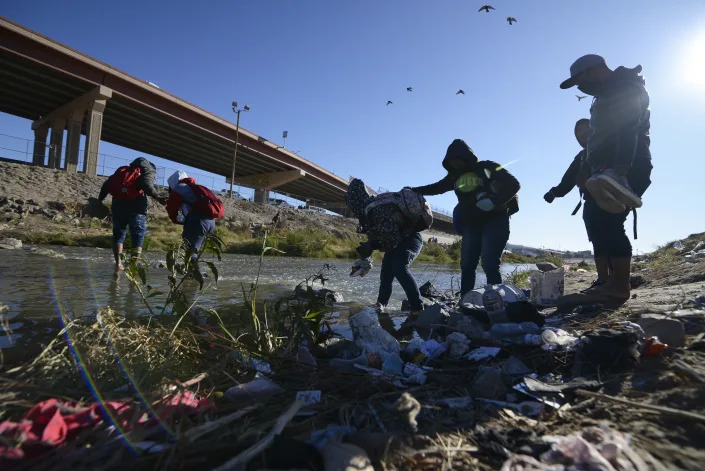

2 / 17
Migrants walk towards the US-Mexico border in Ciudad Juárez, Mexico, Wednesday, Dec. 14, 2022. (AP Photo/Christian Chavez)
ELLIOT SPAGAT
Thu, December 22, 2022 at 7:00 AM MST·6 min read
TIJUANA, Mexico (AP) — In 2014, groups of unaccompanied children escaping violence in Central America overwhelmed U.S. border authorities in South Texas. In 2016, thousands of Haitians fled a devastating earthquake and stopped in Tijuana, Mexico, after walking and taking buses through up to 11 countries to the U.S. border.
In 2018, about 6,000 mostly Guatemalan and Honduran migrants fleeing violence and poverty descended on Tijuana, many of them families with young children sleeping in frigid, rain-soaked parks and streets.
A Trump-era ban on asylum, granted a brief extension by Supreme Court Chief Justice John Roberts on Wednesday, was one of the U.S. policies affecting migrants’ decisions to leave their homes. The last eight years show how an extraordinary convergence of inequality, civil strife and natural disasters also have been prompting millions to leave Latin America, Europe and Africa. Since 2017, the United States has been the world’s top destination for asylum-seekers, according to the United Nations.
___
This is part of an occasional series on how the United States became the world’s top destination for asylum-seekers.
___
Migrants have been denied the right to seek asylum under U.S. and international law 2.5 million times since March 2020 on grounds of preventing the spread of COVID-19, an authority known as Title 42. It applies to all nationalities but has fallen disproportionately on people from countries that Mexico takes back, Guatemala, Honduras, El Salvador and, more recently Venezuela, as well as Mexico. Pent-up demand is expected to drive crossings higher when asylum restrictions end.
When the pandemic hit, nationalities rarely seen at the border grew month after month, from Cuba, Peru, Venezuela, Ecuador, Colombia. High costs, strained diplomatic relations and other considerations complicated U.S. efforts to expel people from countries that Mexico wouldn't take.
Cubans are fleeing their homes in the largest numbers in six decades to escape economic and political turmoil. Most fly to Nicaragua as tourists and slowly make their way to the U.S. They were the second-largest nationality at the border after Mexicans in October.
Grissell Matos Prieguez and her husband surrendered to border agents near Eagle, Pass, Texas, Oct. 30, after a 16-day journey through six countries that included buses, motorcycles and taxis and exhausting night walks through bushes and foul-smelling rivers.
“Throughout all the journey you feel like you are going to die, you don’t trust anybody, nothing,” said Matos, a 34-year-old engineer. “You live in a constant fear, or to be detained and that anything would happen.”
To pay for the trip from Santiago de Cuba, they sold everything, down to computers and bicycles, and borrowed from relatives in Florida. Their parents and grandparents stayed behind.
A recent surge that has made El Paso, Texas, the busiest corridor for illegal crossings is made up largely of Nicaraguans, whose government has quashed dissent.
Haitians who stop in South America, sometimes for years, have been a major presence, most notably when nearly 16,000 camped in the small town of Del Rio, Texas, in September 2021. The Biden administration flew many home but slowed returns amid increasingly brazen attacks by gangs that have grown more powerful since the assassination of President Jovenel Moïse last year.
Migration is often driven by “pull factors” that draw people to a country, such as a relatively strong U.S. economy and an asylum system that takes years to decide a case, encouraging some to come even if they feel unlikely to win. But conditions at home, known as "push factors," may be as responsible for unprecedented numbers over the last year.
Looking back, Tijuana attorney and migrant advocate Soraya Vazquez says the Haitian diaspora of 2016 was a turning point.
“We began to realize that there were massive movements all over, in some places from war, in others from political situations, violence, climate change,” said Vazquez, a San Diego native and former legislative aide in Mexico City. “Many things happened at once but, in the end, men and our governments are responsible.”
After hosting legal workshops for Haitians in Tijuana, Vazquez helped bring chef Jose Andres' World Central Kitchen to the city's migrant shelters for four years. Seeking financial stability, she became Tijuana director of Al Otro Lado, a nonprofit group that reported $4.1 million in revenue in 2020 and was recently named a beneficiary of MacKenzie Scott's philanthropy.
“What provoked all of this? Inequality,” Vazquez said over tea in Tijuana's trendy Cacho neighborhood.
For decades, Mexicans, largely adult men, went to the U.S. to fill jobs and send money home. But in 2015, the Pew Research Center found more Mexicans returned to Mexico from the U.S. than came since the Great Recession ended.
Mexicans still made up one of three encounters with U.S. border agents during the fiscal year that ended Sept. 30, higher than three years ago but well below the 85% reported in 2011 and the 95% at the turn of the century. And those fleeing are increasingly families trying to escape drug-fueled violence with young children.
Like clockwork, hundreds cross the border after midnight in Yuma, Arizona, walking through Mexican shrub to surrender to U.S. agents. Many fly to the nearby city of Mexicali after entering Mexico as tourists and take a taxi to the desert. The Border Patrol releases them to the Regional Center for Border Health, a clinic that charters six buses daily to Phoenix Sky Harbor International Airport.
The health clinic had shuttled families from more than 140 countries by August, not one from Mexico, said Amanda Aguirre, its executive director.
Daniel Paz, a Peruvian who surrendered to border agents in Yuma with his wife and 10-year-old in August, had the surprise misfortune of being expelled home without a chance at asylum, unusual even after the Peruvian government began accepting two U.S. charter flights a week.
Peruvians were stopped more than 9,000 times by U.S. authorities along the Mexican border in October, roughly nine times the same period a year earlier and up from only 12 times the year before.
Paz is watching developments around Title 42 and considering another attempt after the government of Peruvian President Pedro Castillo was toppled Dec. 7.
“We'll see if I'm back in January or February," he texted Sunday from Lima. “There is no lack of desire.”
Tijuana's latest newcomers are Venezuelans, about 300 of whom recently temporarily occupied a city-owned recreational center.
About 7 million Venezuelans fled since 2014, including nearly 2 million to neighboring Colombia, but only recently started coming to the United States.
Many Venezuelans gather at Mexico’s asylum office that opened in Tijuana in 2019 and processed more than 3,000 applications in each of the last two years from dozens of countries, led by Haitians and Hondurans.
Jordy Castillo, 40, said he'd wanted to leave Venezuela for 15 years but didn't act until friends and family started reaching the United States last year. His three brothers were first in his circle to seek asylum there, even though they knew no one.
“They found someone who took them in and got settled,” he said.
__
Associated Press writer Gisela Salomon in Miami contributed.
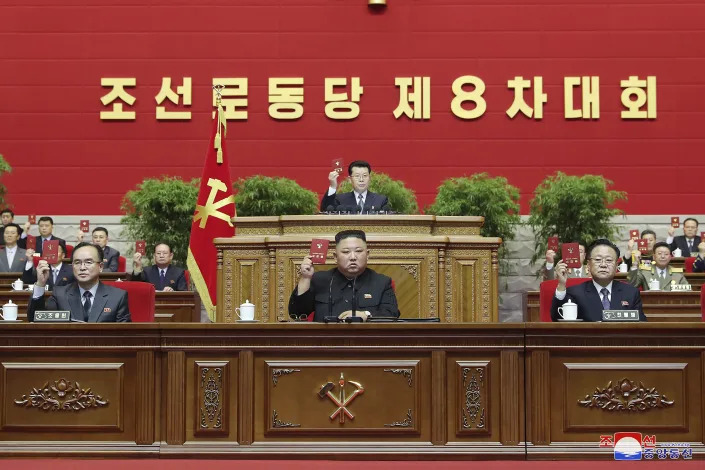
In this photo provided by the North Korean government, North Korean leader Kim Jong Un, bottom center, attends a ruling party congress in Pyongyang, North Korea, on Jan. 12, 2021. North Korean hackers have stolen an estimated 1.5 trillion won ($1.2 billion) in cryptocurrency and other virtual assets in the past five years, more than half of it this year alone, South Korea’s spy agency said Thursday, Dec. 2022.
HYUNG-JIN KIM
Thu, December 22, 2022 a
SEOUL, South Korea (AP) — North Korean hackers have stolen an estimated 1.5 trillion won ($1.2 billion) in cryptocurrency and other virtual assets in the past five years, more than half of it this year alone, South Korea’s spy agency said Thursday.
Experts and officials say North Korea has turned to crypto hacking and other illicit cyber activities as a source of badly needed foreign currency to support its fragile economy and fund its nuclear program following harsh U.N. sanctions and the COVID-19 pandemic.
South Korea's main spy agency, the National Intelligence Service, said North Korea’s capacity to steal digital assets is considered among the best in the world because of the country's focus on cybercrimes since U.N. economic sanctions were toughened in 2017 in response to its nuclear and missile tests.
The U.N. sanctions imposed in 2016-17 ban key North Korean exports such as coal, textiles and seafood and also led member states to repatriate North Korean overseas workers. Its economy suffered further setbacks after it imposed some of the world's most draconian restrictions against the pandemic.
The NIS said state-sponsored North Korean hackers are estimated to have stolen 1.5 trillion won ($1.2 billion) in virtual assets around the world since 2017, including about 800 billion won ($626 million) this year alone. It said more than 100 billion won ($78 million) of the total came from South Korea.
It said North Korean hackers are expected to conduct more cyberattacks next year to steal advanced South Korean technologies and confidential information on South Korean foreign policy and national security.
Earlier this month, senior diplomats from the United States, South Korea and Japan agreed to increase efforts to curb illegal North Korean cyber activities. In February, a panel of U.N. experts said North Korea was continuing to steal hundreds of millions of dollars from financial institutions and cryptocurrency firms and exchanges.
Despite its economic difficulties, North Korea has carried out a record number or missile tests this year in what some experts say is an attempt to modernize its arsenal and boost its leverage in future negotiations with its rivals to win sanctions relief and other concessions.
Jody Serrano
Thu, December 22, 2022
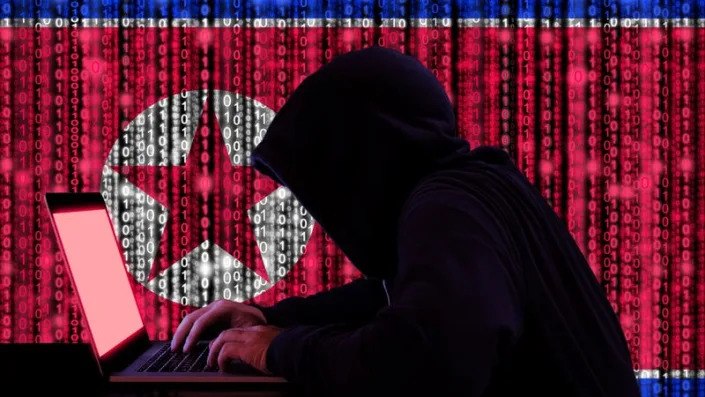
The black silhouette of a hacker on a computer is shown against a North Korean flag.
Missing some crypto? There’s a good chance it was North Korea who took it.
South Korea’s top spy agency revealed on Thursday that state-sponsored North Korean hackers had stolen $1.2 billion in cryptocurrency and other digital assets from targets around the world over the last five years.
The National Intelligence Service stated that more than half of the assets stolen, or about $626 million, had been taken in 2022 alone, the Associated Press reported. Of the total amount snatched this year, more than $78 million was from South Korea. The spy agency expects North Korea to ramp up its cyber attacks on South Korea in 2023 and focus on stealing advanced technologies related to nuclear plants, chips, and the defense industry
“Marking the third year under its five-year economic development plan in 2023, the North is expected to be bent on stealing key technologies, and collecting diplomatic and security intelligence in a bid to meet its policy goals,” the National Intelligence Service said, according to the Yonhap News Agency.
In addition, North Korea is likely to continue engaging in cryptocurrency theft. North Korean hackers are considered to be some of the best in the world at stealing cryptocurrency and digital assets, the National Intelligence Service explained. In fact, the FBI believes that North Korea is responsible for the theft of roughly $625 million from crypto gaming company Axie Infinity this past March. The Axie Infinity theft is the biggest crypto theft in history so far.
The digital thieves honed their skills after the United Nations tightened economic sanctions in 2017, which banned the export of North Korean goods including coal, textiles, and seafood, in response to the country’s test of nuclear weapons and missiles.
The UN sanctions prompted North Korea to focus on cybercrimes. According to U.S. and international experts, the country uses up to a third of the stolen funds to finance its missile program. North Korea is considered one of the world’s foremost nation-based cyberthreats along with China, Russia, and Iran.
As of November of this year, North Korea had carried out 34 weapon tests involving about 88 ballistic and cruise missiles, financed in large part by the country’s illicit activity. In November, the country tested two intercontinental ballistic missiles, which experts say can hit anywhere in the U.S.
More from Gizmodo
Lyllah Ledesma
Thu, December 22, 2022
The U.S. Securities and Exchange Commission (SEC) has called FTX’s FTT exchange token a security. FTT was sold as an investment contract and is a "security," the SEC said in a complaint filed late Wednesday, in a move that is sure to have a wide-ranging impact on the industry. "If demand for trading on the FTX platform increased, demand for the FTT token could increase, such that any price increase in FTT would benefit holders of FTT equally and in direct proportion to their FTT holdings," the SEC wrote in its complaint.
Former Alameda Research CEO Caroline Ellison and FTX co-founder Gary Wang have pleaded guilty to criminal fraud charges tied to FTX's collapse. The SEC and Commodity Futures Trading Commission also announced charges against the two, saying Ellison manipulated the price of FTT. The duo are cooperating with investigators. The U.S. Attorney for the Southern District of New York did not specify what they were being charged with.
Twitter has integrated cryptocurrency prices into search results using a plug-in from charting platform TradingView. The integration allows users to type crypto or stock tickers into the search bar to generate the current value and a price chart. The result also includes a link to trading app Robinhood. The social media giant has had several ties to the crypto industry over the past few years, adding a tipping feature in September 2021 while the company was under the management of Jack Dorsey. Since then, Twitter has been taken over by Elon Musk.
Chart of the Day
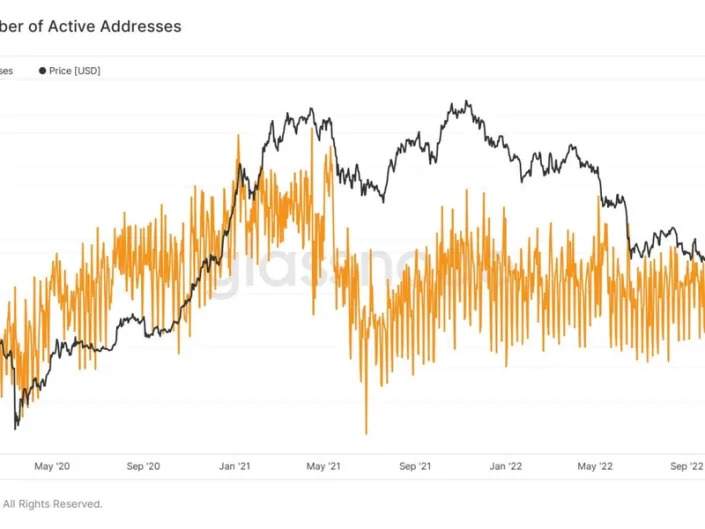
(Glassnode)
The chart shows the number of daily active bitcoin addresses since January 2020. The metric filters out addresses with unsuccessful transactions.
The average number of daily active addresses (DAA) this year has been 921,445 – a 16% drop from the 2021 average of 1.1 million.
"Aside from the decline in trading volumes, the fall in DAA could also correspond to reduced mining operations as miners' activity corresponds to BTC's most significant on-chain movements," the Dec. 12 issue of Bitfinex's Alpha report said.
The greater the active user participation on the blockchain, the higher the demand for and the price of the cryptocurrency.
SEC Calls FTT Exchange Token a Security
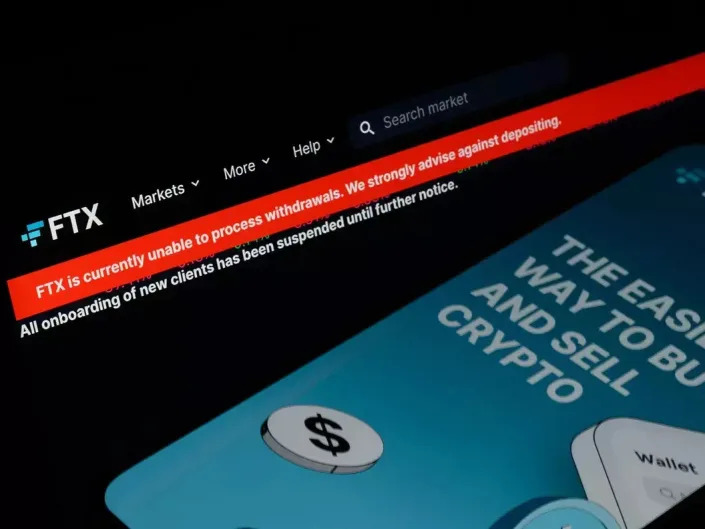
Sam Reynolds
Wed, December 21, 2022 at 9:25 PM MST·2 min read
FTX's exchange token FTT was sold as an investment contract and thus is a "security," the U.S. Securities and Exchange Commission said in a complaint filed late Wednesday, in a move that is sure to have a wide-ranging impact on the industry.
"If demand for trading on the FTX platform increased, demand for the FTT token could increase, such that any price increase in FTT would benefit holders of FTT equally and in direct proportion to their FTT holdings," the SEC wrote in its complaint. "The large allocation of tokens to FTX incentivized the FTX management team to take steps to attract more users onto the trading platform and, therefore, increase demand for, and increase the trading price of, the FTT token."
The SEC made the claim in a complaint filed against FTX co-founder Gary Wang and former Alameda Research CEO Caroline Ellison.
In the complaint, it highlighted that FTX would use proceeds from the token sale to fund the development, marketing, business operations and growth of FTX while using language to emphasize that FTT is an "investment" with profit potential.
"The FTT materials made clear that FTX’s core management team’s efforts would drive the growth and ultimate success of FTX," the complaint read.
FTT's "buy-and-burn" program was also mentioned. This initiative, used by many other exchange tokens, is akin to a stock buyback where revenue from FTX would repurchase and burn FTT, thus increasing its value.
Ellison and Wang have both pled guilty to the various charges brought before them, and are not contesting the SEC's allegations, the agency said in a press release.
The two are also facing Justice Department and Commodity Futures Trading Commission (CFTC) charges related to their conduct at FTX and Alameda, respectively. "FTT investors had a reasonable expectation of profiting from FTX’s efforts to deploy investor funds to create a use for FTT and bring demand and value to their common enterprise." the SEC added.
The price of other exchange tokens don't appear to be moving on the news. The price of Binance's BNB token remained stagnant after the news broke, declining 0.17% during the Asia morning to $248, according to CoinDesk data. Huobi's HT token is down 2% to $5.29, while OKX's OKB token is up 1.3% to $22.82.
A lawyer representing 100 ex-Twitter staff says the company's conduct has been 'incredibly egregious' since Elon Musk took over
A lawyer filed demands for arbitration on behalf of 100 Twitter employees who lost their jobs.
Since Elon Musk took over, Twitter's conduct has been "incredibly egregious," Shannon Liss-Riordan said.
She added that this was just the "first wave" of arbitration demands against the company.
A lawyer representing former Twitter staff says that the company's conduct has been "incredibly egregious" since new owner and CEO Elon Musk took over in late October.
Shannon Liss-Riordan on Tuesday filed 100 demands for arbitration on behalf of 100 former Twitter employees who lost their jobs and signed arbitration agreements after Musk bought the company, according to a press release from her firm, Lichten and Liss-Riordan.
"My firm has spoken with hundreds of Twitter employees who are seeking to preserve their rights and receive the compensation they are owed," Liss-Riordan said in a statement.
"The conduct of Twitter since Musk took over is incredibly egregious, and we will pursue every avenue to protect workers and extract from Twitter the compensation that is due to them."
She added that this was just the "first wave" of arbitration demands against the company. "More are coming," she said.
Liss-Riordan told Reuters that the workers had signed agreements saying they would bring legal disputes against the company in arbitration rather than in court, likely barring them from participating in the four pending class-action lawsuits she has already filed against Twitter.
The law firm said that Tuesday's filings incorporated claims that had already featured in the class-action suits, including accusing the company of breach of contract related to severance pay, of targeting female workers with layoffs, and of laying off staff on parental or medical leave in violation of federal law.
Some of the new filings also include claims that employees lost their jobs because Musk had placed "unreasonable demands" on the workforce.
After Musk's $44 billion takeover deal went through on October 27, he swiftly fired some of the company's top execs, including CEO Parag Agrawal and CFO Ned Segal.
The next week Musk started laying off staff, with around half of the company's 7,500-strong workforce being cut. Musk also began firing some workers who criticized him and his leadership of the company.
Remaining employees were then given an ultimatum. Staff were asked to respond to an email from Musk and commit to his vision for "Twitter 2.0," which he said would involve working "long hours at high intensity." Staff who didn't sign up by a certain cutoff time were laid off.
One of the pending class-action lawsuits filed by Liss-Riordan in California accused the company of pushing disabled employees to leave because they didn't feel they could meet the new performance standards.
Twitter did not immediately respond to a request for comment from Insider.
William Harwood
Thu, December 22, 2022
Astronauts Josh Cassada and Frank Rubio spent seven hours outside the International Space Station Thursday, successfully installing a fourth set of roll-out solar array blankets in an ongoing $103 million power system upgrade.
"Outstanding job today," radioed Nick Hague from mission control. "You made it look easy and routine ... You've got a lot of people who are very glad they're holiday plans are still secure!"
"We're incredibly happy that that's the case," said Rubio, laughing, back inside the space station airlock.
Joked Cassada: "Frank and I are going to put in for some leave."

Josh Cassada, left, and Frank Rubio prepare rolled-up solar array blankets for installation aboard the International Space Station as the lab complex approach the southwest coast of Africa. / Credit: NASA TV
Senior station managers, meanwhile, said Russia is holding open the possibility of launching a replacement Soyuz crew ferry ship to replace a virtually identical craft now docked at the station that suffered a major coolant leak last week.
But a final decision is not expected until engineers complete their analysis of a small hole in the Soyuz MS-22/68S spacecraft. The damage and subsequent coolant leak apparently were caused by a micrometeoroid or space debris impact last week that ruptured a radiator coolant line.
If engineers conclude the damaged Soyuz cannot safely carry its three-man crew back to Earth as planned in late March, a Soyuz scheduled to carry their replacements to the space station could be moved up a few weeks and launched without a crew on board. The damaged Soyuz would make an unpiloted return to Earth for additional analysis.
Under that scenario, it's not clear when Soyuz MS-22/68S commander Sergey Prokopyev, Dmitri Petelin and NASA astronaut Frank Rubio would come home, or when their replacements might be launched.
Back aboard the ISS, Cassada and Rubio switched their spacesuits to battery power at 8:19 a.m. EST Thursday, officially kicking off the 257th spacewalk devoted to station assembly and maintenance, and the 12th this year.
The goal of the excursion was to install the second of two ISS Roll-Out Solar Array blankets — IROSAs — that were carried to the space station aboard a SpaceX Dragon cargo ship on Nov. 22.
The station is equipped with four huge rotating solar wings, two on each end of a truss stretching the length of a football field. Each of the four wings is made up of two sets of solar cells extending in opposite directions from a central hub.

The new ISS Roll-Out Solar Array (IROSA) blankets unroll after installation, extending in front of an original-equipment array in the background. The new IROSA blankets are smaller than the space station's original solar wings, but they are more efficient and will eventually generate an additional 120 kilowatts of power. / Credit: NASA TV
The eight sets of blankets deliver electricity to eight main circuits, or power channels, during daylight to operate the lab's systems and to recharge batteries. The stored battery power is used when the station is in orbital darkness.
The power system needs an upgrade because the first set of original-equipment blankets, located on the left end of the station's power truss, have been in space for more than 20 years. Subsequent wings were added in 2006, 2007 and 2009.
All of them have suffered degradation from years in the harsh space environment, and they do not generate as much power as they did when they were new. In a major upgrade, NASA is installing the smaller but more-powerful IROSA blankets to augment the output of the original-equipment blankets.
The first two IROSA blankets were installed on the left-side outboard arrays — the oldest set on the station — during spacewalks in 2021. Cassada and Rubio carried out two earlier spacewalks to install mounting brackets, and one of the two new IROSAs on a right-side inboard wing to augment power channel 3A.
During Thursday's excursion, the second new IROSA was attached to an inboard left-side array to boost power channel 4A. A final set of IROSAs are scheduled for delivery to the station next year.
The IROSA blankets are about half the size of the original arrays, but they are more efficient and will eventually generate an additional 120 kilowatts of power. They were designed to be mounted on brackets at the base of an existing wing, extending outward at a 10-degree angle to minimize the shade they cast on the array below.
Once all six roll-out arrays are installed, overall power generation will be boosted between 20 and 30 percent, roughly matching the output of the original arrays when they were new.
Upwallstreet
Thu, December 22, 2022

Nike (NYSE: NKE) shares rose after quarterly earnings showed buoyant North America sales. Despite heavy discounting due to excessive inventory hitting profit margins and causing flat profits on higher sales, the US athleisure company topped estimates. Its European’s peers also gained from Nike's good news, with Puma (PTC: PUMSY) and adidas AG (OTC: ADDYY) both rising roughly 6 per cent in Frankfurt, while JD.com Inc. (NASDAQ: JD) jumped 8 per cent in London.
Nike did it again, despite a challenging environment
With high consumer demand that drove a strong business momentum in a dynamic environment, Nike’s management stayed focus on what it can control. Although inventories rose 43% compared to last year, they declined from the previous quarter. For the quarter that ended on November 30th, revenues rose 17 percent to $13.3 billion while profits remained flat compared to the year ago period, amounting to $1.3 billion.
Direct sales amounted to $5.4 billion, rising 16 percent for the quarter, with digital sales also rising 25 percent due to record growth in the brand’s digital membership platform.
Gross margin declined compared with the prior quarter due to higher markdowns, especially in North America with profit margins also pressured by higher marketing, logistics and freight costs.
As for China that was shaped by COVID-19 restrictions, sales did drop 3 percent but, it is still a far more gentle drop compared to prior quarter’s 16%.
The success secret
Chief Financial Officer Matthew Friend explained that the challenging market conditions were offset by strong demand, especially in North America where revenue rose 30% from last year’s comparable period. Nike’s strategy of shifting its sales directly to consumers and becoming a ‘direct-to-consumer’ brand is undoubtedly working.
New (streaming) horizons
As of December 30th, Netflix will start streaming Nike Training Club classes, taking a page from Peloton’s (NASDAQ: PTON). Nike Training Club is the company's fitness app that hosts videos of strength, yoga, and high-intensity interval training. By including Nike's speciality content, Netflix made a smart move to lure exercisers stay on their platform while doing fitness and Nike only continued expanding its already impressive global presence, something it is well known for and that many find to be one of the secrets behind its success.
Despite costs squeezing margins, Nike now sees its revenue growing for the full fiscal year. Like many other times throughout its history, Nike again showed it why it deserves its market leader title, year after year.
Derek Decloet
Thu, December 22, 2022


(Bloomberg) -- Brookfield Asset Management Ltd. has had a bumpy start as a standalone public company. That may represent an opportunity for investors, according to some Wall Street analysts who are picking up coverage of the firm.
Brookfield Asset has dropped roughly 13% since it began trading in New York on Dec. 12. It was spun out from its parent, now called Brookfield Corp., to create a investment-management company that intends to pay out the vast majority of its earnings in dividends.
The Canadian firm runs about $400 billion in private funds and other investment strategies, making it the world’s No. 2 alternative asset manager. Its funds have a strong tilt toward credit, infrastructure and hard assets and an aggressive growth target — $1 trillion in assets by 2027.
“They kind of are in the best place to be right now,” Goldman Sachs analyst Alex Blostein said in a phone interview. “Within private markets, the two things that really resonate today are credit and infrastructure. And then within infrastructure, there’s a tremendous amount of focus on clean energy.”
The goal of the spinoff is to get a higher multiple for the fund-management business then when it was embedded in a conglomerate. It should trade at around 20 times earnings or more, Blostein said, based on the valuations of peers including Blackstone Inc. and Ares Management Corp.
Goldman rates Brookfield Asset a buy with a $40 price target; that would imply 42% upside from Wednesday’s close of $28.20. The average price target of analysts tracked by Bloomberg is $34.35 with five rating it a buy and four saying hold. None recommend selling the stock.
Brookfield is counting on credit to drive much of its growth after it acquired Howard Marks’s Oaktree Capital Group three years ago and expanded its insurance business. Brookfield’s real estate funds and private-equity group may become relatively less important to the overall business, according to a company presentation.
Some of the asset growth may come through acquisitions, Chief Executive Officer Bruce Flatt suggested at a Goldman conference earlier this month. Having its own stock will make it easier for the asset manager to make deals, “if opportunities come along that we think are as good as what we have,” said Flatt, who’s also CEO of Brookfield Corp.
There are, however, a few hurdles to cross on the way to $1 trillion. In the short term, higher interest rates may be one of the biggest.
Toronto-based Brookfield has thrived as it built up an investment track record that attracted heaps of capital from large pension and sovereign wealth funds seeking stable, cash-producing assets like utilities and toll roads as an alternative to bonds. The sharp rise in government yields has taken the shine off such alternative strategies.
“BAM benefited significantly and grew massively in very large part, in our opinion, due to ever declining interest rates that enabled them to attract more and more capital,” said Dimitry Khmelnitsky, head of accounting and special situations at Toronto-based Veritas Investment Research Corp.
Khmelnitsky sees rates as a bigger problem for alternative asset managers like Brookfield than most investors are factoring in. All of Brookfield Corp.’s publicly traded divisions have underperformed the S&P 500 in this year’s rate-driven equity selloff.
As a result, the analyst thinks Brookfield Asset Management should trade at a more modest valuation of 15 times earnings — which, he adds, is not far off from the multiple that Brookfield paid to acquire Oaktree in 2019.
Other analysts don’t see rates as a major roadblock for Brookfield, especially given that it’s not that reliant on private equity, where a shortage of debt financing has slowed down dealmaking.
“If we look on a longer time frame, rates aren’t really that high in a historical context,” Credit Suisse analyst Andrew Kuske said. Brookfield Asset “is a very large business and has very good momentum on a number of fronts — on fundraising, deployments, client reach.”
The National Highway Traffic Safety Administration says that it received "information" on Hertz.
DEC 21, 2022 3:
Car-rental company Hertz (HTZZW) is once again in hot water after a year of navigating a false theft report lawsuit, rising car prices and recalls and a changing post-pandemic driving landscape.
This year has seen several large-scale recalls of many popular car models. In December, General Motors (GM) - Get Free Report recalled more than 740,000 cars over issues with daytime running lights. Tesla (TSLA) - Get Free Report recalled over 1.1 million cars in September over window closures while reports of car fires prompted Ford (F) - Get Free Report to recall nearly half a million cars in the same year.
These are just some examples of the many more widespread auto recalls at a time when a global semiconductor shortage and supply chain disruption is already limiting the number of new cars leaving factories. Some estimates found that global carmarkers produced 8 million fewer cars than planned in 2022.
'Without Having Performed Required Safety Recalls'
While this has sent the price of both new and used cars skyrocketing, it is still not a reason to forgo safety. In a filing published on Tuesday, the National Highway Traffic Safety Administration (NHTSA) announced that it was investigating whether Hertz had still rented cars that had been subject to safety recalls.
"NHTSA is in receipt of information that indicates Hertz rented vehicles to customers without having performed required recall repairs," the agency said in a public filing. "Accordingly, we are opening this audit query to seek additional information concerning this issue."
Individual owners of recalled cars are customarily given time to replace them free-of-charge but not everyone performs this in a timely fashion. For a car rental company, this could also take away from a given car's availability while it is being replaced.
NHTSA said that the investigation concerns recalls over latches and locks on Ford Explorer and Nissan Altima (NSANF) cars that Hertz owned between 2018 and 2020. The investigation is currently looking for "additional information concerning this issue" to determine Hertz did anything wrong.
"The Safety Act requires, among other things, that a rental company shall not rent a vehicle subject to a safety recall unless the recall remedy has been performed," NHTSA said in reference to a 2015 law for rental companies with over 35 vehicles.
Hertz told TheStreet that it was "looking forward to working with NHTSA on the review."
"We take the safety of our customers seriously and manage the Hertz fleet of approximately 500,000 cars around the world with that as our principal objective," a company spokesperson said. "Our policies require us to remove from our rentable fleet vehicles that are under a safety recall, consistent with applicable law."




